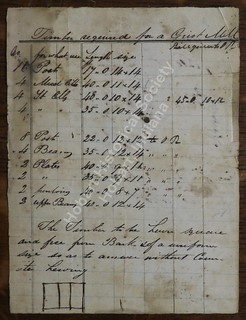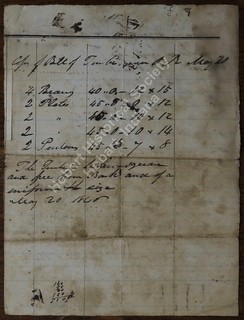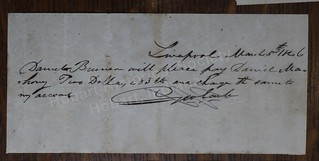
(Click on images to enlarge)
Images courtesy of the Hobart Historical Society.
"The timber to be hewn square and free from Bark & of a uniform size so as to answer without counter hewing."
On the other side, we find a date of May 20, 1846 …

… which I suppose would put it in the time frame of the planning stages for Hobart's famous old mill. I'd like to think that here we have the recipe for the old mill in George Earle's own handwriting, but of course I can't say for sure!
[1/19/2018 update] After more indexing work with the ledgers, especially those dating close to 1846, I am feeling more confident that the grist-mill recipe above is indeed in George Earle's own handwriting. I certainly could be wrong — I am not a handwriting expert, and I had to make assumptions and comparisons that could be mistaken.
Here is what I used for comparison: first, I had posted what I believed to be George Earle's signature, which I found in the ledger that begins in 1835. The signature has a distinctive style, especially in the way he forms his G. As for the text above each signature, I didn't know if that was in George Earle's hand, but was inclined to think not.
While indexing the daybook that begins in 1836 — the one where I originally found the list of "timber required for a grist mill" — I came across another interesting loose piece of paper:

(Click on image to enlarge)
Image courtesy of the Hobart Historical Society.
There's that distinctive signature again, only this time, I think the same hand wrote the text above the signature as well. The writing just looks the same.
Comparing this loose sheet, as well as the signatures we saw earlier, to the list of timber above, I see some clear similarities in the writing — particularly in the style of the capital G and M, as well as the general slant and the joining of the letters.
But as I said, I am not a handwriting expert, and I could be wrong. If we ever get our hands on some writing that is definitely known to be George Earle's own, we will be in a better position to compare.


3 comments:
I think this is pretty dang exciting, but I'm a history geek.
What else could it be but George Earle's shopping list for lumber?
It was found in the museum, where someone who cared made sure it ended up.
There must be other examples of George Earle's handwriting to compare to.
It would be easy to use the scale mill in the museum to calculate the lengths of the timbers, and see if the usage matches the list.
The sketched frame diagram is very close to the proportions of Earle's mill,
and Oaks of useful size were probably very near.
Yes, those things would be worth investigating ... by someone who has the time, i.e., not me.
Tom here. Hoping I have time to investigate this someday somehow.
No time now, but let's consider who else would be planning a grist mill in 1846 in Lake County and draw up a timber list?
It sure as heck wasn't John Woods, who had his hands full fighting beavers and woodchucks, and had a brick mill upstream.
There must be some examples of George Earle's handwriting.
The book is probably from his Liverpool years.
Post a Comment